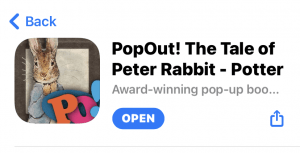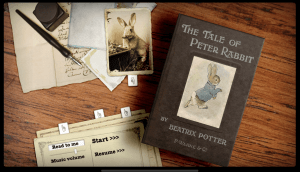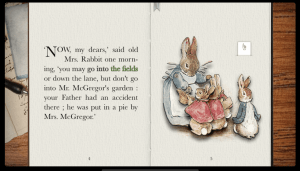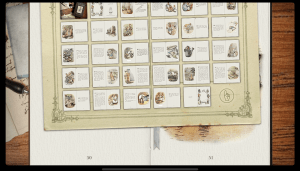
Loud Crow Interactive (2017) creates premium digital books that engage readers of all ages through innovative digital adaptions of print-born texts. A retelling of the classic children’s story by Beatrix Potter (1893), Loud Crow’s PopOut! The Tale of Peter Rabbit is an award-winning enhanced picture book designed for convenient reading on smartphone and tablet platforms. Targeting readers four years and above, this picture book integrates digital affordance amidst the classic literature. The reader meets a mischievous rabbit named Peter, who goes off on an adventure with dangerous consequences despite his mother’s warning. PopOut! is accessible through the Apple App store, Google Play, Amazon, and Nook for $4.49.

Once the application is opened, the readers are transported to a faux desktop with papers, an inkpot, and a quill and are serenaded by soft piano music. The page also hosts a copy of the digital-book, music options, [start] and [resume] icons, and four finger-tabs that, when slid by the reader, reveal the reading options, Loud Crows privacy policy, links to additional PopOut! Picture books and a movable photograph of Peter Rabbit. Before starting the book, readers should select their reading preference – ‘read myself’ or ‘read to me’ (Reich et al., 2016, p. 585). If the readers’ preference is not selected, ‘read to me’ is the default setting. The narrator’s voice is soft, articulate, and well-paced, and when in temporal contiguity with the piano music, it makes for a pleasant reading experience (Roskos et al., 2014, p. 5). As the narrator reads, the text is highlighted, allowing for easy word tracking to occur (Segal-Drori et al., 2010, p. 915). Once the narrator ends a page, the reader may select any word by tapping on it, and the narrator will repeat the word for clarification. Additionally, a small, semi-transparent repeat icon is located at the end of each page, which when selected, allows the page to be re-read. Unlike some interactive picture books, PopOut! does not have a definition option, disadvantaging readers who may want to clarify any unfamiliar words (Shamir & Shlafer, 2011, p. 1990).

The reader may either tap the start button or the books cover to begin the story. Like traditional picture books, the reader turns the pages within PopOut!; instead of the action of scrolling found in some digitised texts, these pages are turned through side-swipes and can be turned at the reader’s convenience. This user interface is extended further by the interactive images found throughout the text (James & De Kock, 2013, p. 118). Like the title page, finger-tabs can be selected throughout the reading process and, when slid or turned, allow the reader to bring the illustrations to life through basic movements and sounds. This is a familiar technique seen in traditional popup picture books, albeit this technique has been adapted for a digital audience (Rockweiler, 1993). Utilising the illustrations found in the original picture book, through PopOut! readers also have the ability to tap on most images and produce page rustles, sound effects or movements. In particular, leaves and berries can be selected throughout the reading experience, pulled out of the illustration, placed around the screen, and tilted or slid by the reader. Furthermore, some illustrations have film-like qualities, with moving backgrounds and automatic components, adding to the aesthetic experience (Yokota & Teale, 2014, p. 578). There is also a virtual bookmark at the top of each page, that when pulled (slid) by the reader, leads to page selection; subsequently also allowing for page skipping, which can disturb the reading process and narrative linearity (Yokota & Teale, 2014, pp. 581-582).

Narratologically speaking, PopOut! highlights Potter’s ability to use precise, descriptive writing techniques to build moral allegory, suspense and tension, and her ability to create atmospheric scenes that engage young readers (Lodge, 1993, p. 14, 143, & 229). Through this fable, the anthropomorphic animal characters can teach readers the importance of obedience, making the reading experience both fun and educational (Combes, 2016). Unlike the traditional tale of Peter Rabbit, which was translated into various languages, PopOut! is only available in standard English.
PopOut! is the perfect text to engage young english readers with classic literature, as it provides them with appropriate learning opportunities to explore traditional reading conventions amidst early digital reading skills (Reich et al., 2016, p. 589). Moreover, in the early years, reading for enjoyment and dyad reading (in this case remind with the narrator) are detrimental in the development of word recognition, print concepts, grammar, and phonological awareness (Bird, 2011, p. 1). PopOut! also aligns with the Australian Curriculums general capabilities of Literacy and ICT and supports foundational English, especially ACELA1433, where concepts about reading print and on screens are explored (ACARA).
Word count: 754
Reference List
Australian Curriculum, Assessment and Reporting Authority (ACARA). N.D. Australian Curriculum: General capabilities. https://www.australiancurriculum.edu.au/f-10-curriculum/general-capabilities/
Australian Curriculum, Assessment and Reporting Authority (ACARA). N.D. Australian Curriculum: Learning Areas. https://www.australiancurriculum.edu.au/f-10-curriculum/learning-areas/
Bird, E. (2011). Planet app: Kids’ book apps are everywhere. But are they any good? School Library Journal, 57(1), p. 26-31. https://primo.csu.edu.au/permalink/61CSU_INST/15aovd3/cdi_gale_infotraccpiq_245541120
Combes, B. (2016). Digital literacy: A new flavour of literacy or something different? Synergy, 14(1). https://doi.org/10.13140/RG.2.1.2609.8804
James, R. & De Kock, L. (2013). The digital David and the Gutenberg goliath: the rise of the ‘enhanced’ e-book. English Academy Review, 30(1), 107-123. https://doi.org/10.1080/10131752.2013.783394
Lodge, D. (1993). The art of fiction: Illustrated from classic and modern texts. New York, Viking. https://silo.pub/the-art-of-fiction-illustrated-from-classic-and-modern-texts.html
Loud Crow Interactive Inc. (2017). PopOut! The tale of Peter Rabbit – Beatrix Potter. https://loudcrow.com/popout-the-tale-of-peter-rabbit/
Potter, B. (1893). The tale of Peter Rabbit. Frederick Warne and Co. London.
Reich, S., Yau, J., & Warschauer, M. (2016). Tablet-Based eBooks for young children: What does the research say? Journal of Developmental & Behavioural Paediatrics, 37(1). http://doi.org/10.1097/DBP.0000000000000335
Rockweiler, S. (1993, Oct 24th). Popout culture. Milwaukee Journal.https://primo.csu.edu.au/permalink/61CSU_INST/15aovd3/cdi_proquest_newspapers_333597934
Roskos, K., Burstein, K., Shang, Y., & Gray, E. (2014). Young children’s engagement with e-books at school: does device matter? Sage Open, pp. 1-9. https://doi.org/10.1177/2158244013517244
Segal-Drori, O., Korat, O., Shamir, A., & Klien, P.S. (2010). Reading electronic and printed books with and without adult instruction: Effects on emergent reading. Reading & Writing, 23(8), pp. 913–930., https://doi.org/10.1007/s11145-009-9182-x
Shamir, A. & Shlafer, I. (2011). E-Books effectiveness in promoting phonological awareness and concept about print: A comparison between children at risk for learning disabilities and typically developing kindergarteners. Computers and Education, 57(3), pp. 1989–1997. https://doi.org/10.1016/j.compedu.2011.05.001
Yokota, J. & Teale, W. H. (2014). Picture books and the digital world: educators making informed choices. The Reading Teacher, 34(6). https://doi.org/10.1002/trtr.1262